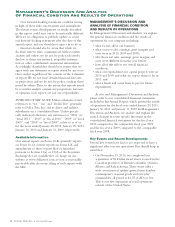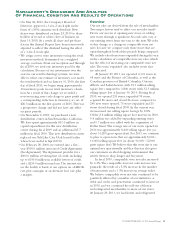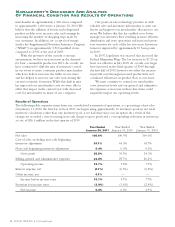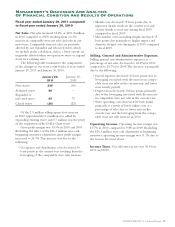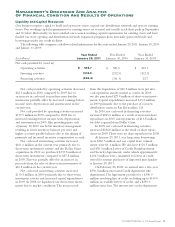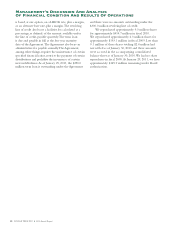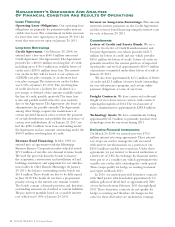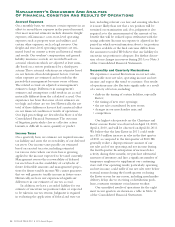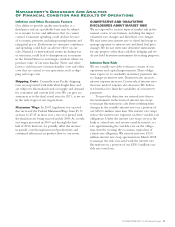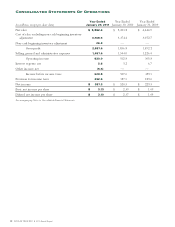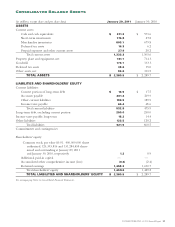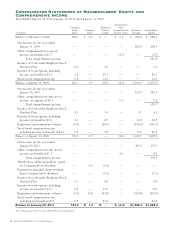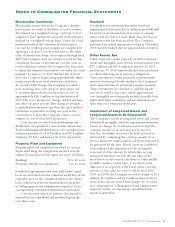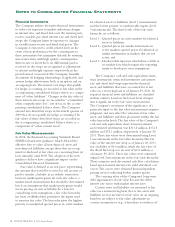Dollar Tree 2010 Annual Report Download - page 26
Download and view the complete annual report
Please find page 26 of the 2010 Dollar Tree annual report below. You can navigate through the pages in the report by either clicking on the pages listed below, or by using the keyword search tool below to find specific information within the annual report.Management’s Discussion And Analysis
Of Financial Condition And Results Of Operations
laws, including relevant case law, and assessing whether
it is more likely than not that a tax position will be
sustained on examination and, if so, judgment is also
required as to the measurement of the amount of tax
benefi t that will be realized upon settlement with the
taxing authority. Income tax expense is adjusted in the
period in which new information about a tax position
becomes available or the fi nal outcome differs from
the amounts recorded. We believe that our liability for
uncertain tax positions is adequate. For further discus-
sion of our changes in reserves during 2010, see Note 3
of the Consolidated Financial Statements.
Seasonality and Quarterly Fluctuations
We experience seasonal fl uctuations in our net sales,
comparable store net sales, operating income and net
income and expect this trend to continue. Our results
of operations may also fl uctuate signifi cantly as a result
of a variety of factors, including:
• shifts in the timing of certain holidays, especially
Easter;
• the timing of new store openings;
• the net sales contributed by new stores;
• changes in our merchandise mix; and
• competition.
Our highest sales periods are the Christmas and
Easter seasons. Easter was observed on April 12, 2009,
April 4, 2010, and will be observed on April 24, 2011.
We believe that the later Easter in 2011 could result
in a $15.0 million increase in sales in the fi rst quarter
of 2011 as compared to the fi rst quarter of 2010. We
generally realize a disproportionate amount of our
net sales and of our operating and net income during
the fourth quarter. In anticipation of increased sales
activity during these months, we purchase substantial
amounts of inventory and hire a signifi cant number of
temporary employees to supplement our continuing
store staff. Our operating results, particularly operating
and net income, could suffer if our net sales were below
seasonal norms during the fourth quarter or during
the Easter season for any reason, including merchandise
delivery delays due to receiving or distribution prob-
lems, consumer sentiment or inclement weather.
Our unaudited results of operations for the eight
most recent quarters are shown in a table in Note 11
of the Consolidated Financial Statements.
Accrued Expenses
On a monthly basis, we estimate certain expenses in an
effort to record those expenses in the period incurred.
Our most material estimates include domestic freight
expenses, self-insurance costs, store-level operating
expenses, such as property taxes and utilities, and
certain other expenses, such as legal reserves. Our
freight and store-level operating expenses are esti-
mated based on current activity and historical trends
and results. Our workers’ compensation and general
liability insurance accruals are recorded based on
actuarial valuations which are adjusted at least annu-
ally based on a review performed by a third-party
actuary. These actuarial valuations are estimates based
on our historical loss development factors. Certain
other expenses are estimated and recorded in the
periods that management becomes aware of them.
The related accruals are adjusted as management’s
estimates change. Differences in management’s
estimates and assumptions could result in an accrual
materially different from the calculated accrual. Our
experience has been that some of our estimates are
too high and others are too low. Historically, the net
total of these differences has not had a material effect
on our fi nancial condition or results of operations.
Our legal proceedings are described in Note 4 of the
Consolidated Financial Statements. The outcome
of litigation, particularly class or collective action
lawsuits, is diffi cult to assess, quantify or predict.
Income Taxes
On a quarterly basis, we estimate our required income
tax liability and assess the recoverability of our deferred
tax assets. Our income taxes payable are estimated
based on enacted tax rates, including estimated
tax rates in states where our store base is growing,
applied to the income expected to be taxed currently.
Management assesses the recoverability of deferred
tax assets based on the availability of carrybacks of
future deductible amounts and management’s projec-
tions for future taxable income. We cannot guarantee
that we will generate taxable income in future years.
Historically, we have not experienced signifi cant
differences in our estimates of our tax accrual.
In addition, we have a recorded liability for our
estimate of uncertain tax positions taken or expected
to be taken in our tax returns. Judgment is required
in evaluating the application of federal and state tax
24 DOLLAR TREE, INC. ♦ 2010 Annual Report


